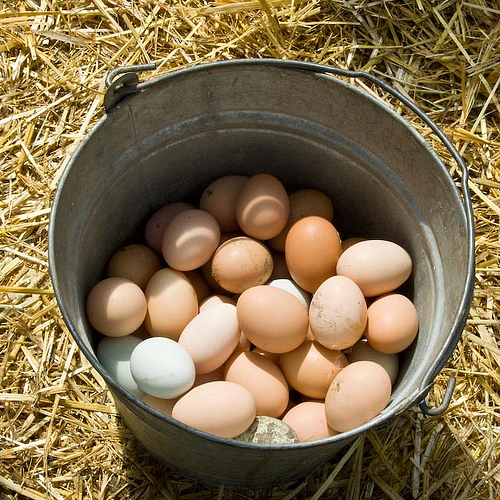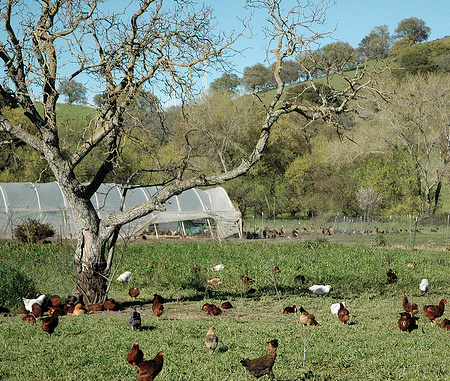 Chickens roaming free at Soul Food Farm.Photo: Christy McDonaldMy partner and I raise chickens for meat and eggs on 55 acres — a small farm by today’s standards. Along the way, I’ve had to make many tough decisions, be inventive, develop relationships with our customers, and work a lot of 14-hour days to insure our farm’s progress.
Chickens roaming free at Soul Food Farm.Photo: Christy McDonaldMy partner and I raise chickens for meat and eggs on 55 acres — a small farm by today’s standards. Along the way, I’ve had to make many tough decisions, be inventive, develop relationships with our customers, and work a lot of 14-hour days to insure our farm’s progress.
The work is hands-on. I spend most of the day out in the pastures collecting eggs by hand, replenishing the birds’ food and water, building coops and shade houses, and managing compost piles. I’m proud of what we do — but I can’t afford to give the birds organic feed.
While certified organic feed is desirable, many chickens are fed organic grains but are still raised in confined quarters. And, when faced with the choice, I believe that treating animals well — and giving them the freedom to walk and roam around, and enjoy their natural behaviors and habitats — is the most important piece of the puzzle. Organic grains will not alleviate the inhumane conditions of overcrowded barns, poor housing, poor water quality, or lack of access to fresh pastures and forage (nor the diseases associated with those conditions).
Why do we have to choose? The answer — as is often the case in farming — is cash flow.
The cost of conventional grain has risen 30 percent since the beginning of 2011. This is a considerable increase, since we already spend over $8,000 a month on feed. By our calculations, organic feed would cost as much as 75 percent more. In short, it’s financially impossible. If we passed the cost on to our customers (a step that would result in our birds retailing at over $35 apiece), we’d be priced out of the market.
 Eggs from Soul Food Farm.Photo: Christy McDonald My partner and I have spent considerable time discussing what to feed our chickens. And while conventionally grown feed is produced in ways that we don’t agree with, small-scale pastured chicken farming is already expensive. The farm fronts all the costs of purchasing and caring for both the laying hens and meat birds — and in the case of layers, we need to make a six-month commitment before we ever collect an egg to sell. When it comes to the meat birds, even after the 10 weeks it takes to raise them, we still have the costs of transporting them to the processor, slaughtering and packaging, and finally, transporting them to market. And because we’re small, we receive no discounts on feed or slaughter costs. And because we’ve focused mainly on chickens, we don’t sell an array of other products to offset our expenses.
Eggs from Soul Food Farm.Photo: Christy McDonald My partner and I have spent considerable time discussing what to feed our chickens. And while conventionally grown feed is produced in ways that we don’t agree with, small-scale pastured chicken farming is already expensive. The farm fronts all the costs of purchasing and caring for both the laying hens and meat birds — and in the case of layers, we need to make a six-month commitment before we ever collect an egg to sell. When it comes to the meat birds, even after the 10 weeks it takes to raise them, we still have the costs of transporting them to the processor, slaughtering and packaging, and finally, transporting them to market. And because we’re small, we receive no discounts on feed or slaughter costs. And because we’ve focused mainly on chickens, we don’t sell an array of other products to offset our expenses.
By far the most daunting cost on our farm is the chickens’ feed. After researching our options, we chose to buy non-organic feed and do business with a small, owner-operated mill less than an hour away in Petaluma, Calif. This mill buys as much grain as they can from California growers; and they don’t add hormones, antibiotics, or anything synthetic to the grains. What I like about the mill is that I have the opportunity to talk with the people there every time I buy the feed. And that’s just as important as ensuring that our customers have the ability to visit the farm and talk directly to us as their farmers.
 Photo: Kate Farnady I don’t buy grain from sources where I cannot speak to a person involved in the growing or milling process. So many of the grains that go into animal feed come from other countries (China has recently become one of the leading producers of the soy used in animal feed, for instance). And I would want to investigate the conditions of their soil, water, and work environments before I invested in markets so far from my own farm.
Photo: Kate Farnady I don’t buy grain from sources where I cannot speak to a person involved in the growing or milling process. So many of the grains that go into animal feed come from other countries (China has recently become one of the leading producers of the soy used in animal feed, for instance). And I would want to investigate the conditions of their soil, water, and work environments before I invested in markets so far from my own farm.
Although it’s far from the current reality, one of the most transformative innovations — and I believe the most ideal method for grain acquisition — would be an independent system owned and controlled by local farmers. The grains would have to be grown far from pesticide and herbicide drift and GMO contamination. They could then be sold to a neighboring mill or cooperative. Local animal farmers could access organic grains at an affordable price; producers would have a constant and steady market year round; and communities would benefit from the rebuilding of rural economies. We’d also have transparency and traceability, straight from the field, to the mill, to the animals.



